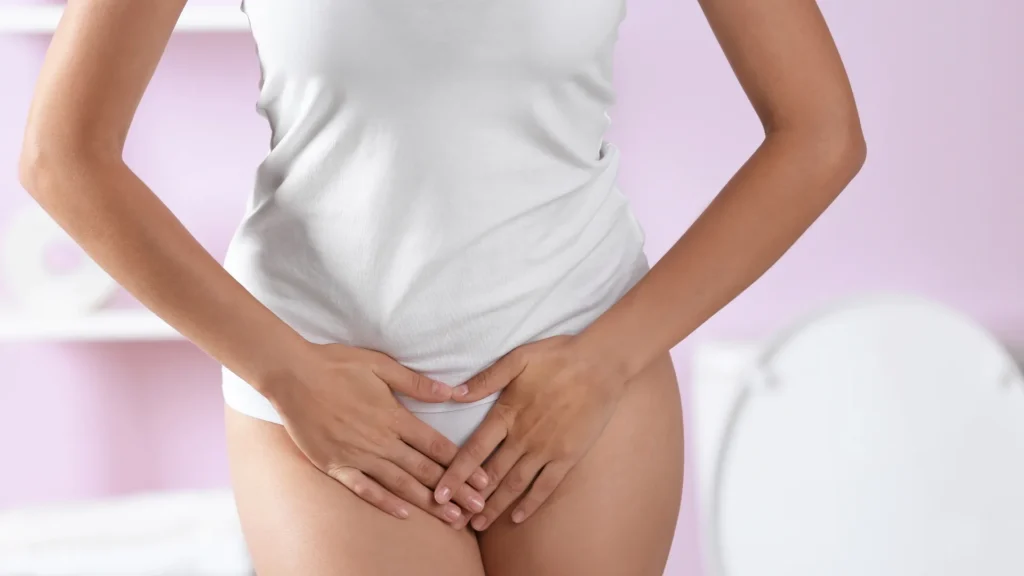You’ve just given birth to a beautiful baby after months of anticipation. You’re overjoyed, exhausted, and ready to embrace your new role as a mother. But as the weeks pass, you start to notice something doesn’t feel quite right “down there.” There’s a strange heaviness, maybe even a bulge. You wonder, “Is this normal? Should I be worried?” These symptoms could be signs of postpartum prolapse, a common yet frequently undiscussed challenge that many new mothers face.
Postpartum prolapse occurs when one or more pelvic organs descend from their normal position, potentially causing discomfort and other symptoms. While it might sound alarming, you’re not alone. This condition affects a significant number of women who have given birth, though exact statistics vary.
It’s a topic that deserves more attention, as many women struggle with its effects without realizing what’s happening or knowing where to turn for help. Postpartum prolapse can range from mild to severe, and its impact on daily life can vary greatly.
In this article, we’ll explore postpartum prolapse, examining what it is, why it happens, and most importantly, what you can do about it. Whether you’re a new mom grappling with these changes or simply curious about the realities of postpartum life, this guide will shed light on an important aspect of maternal health.
Understanding our bodies is the first step towards reclaiming our comfort and confidence after childbirth. Let’s uncover the facts about postpartum prolapse and empower ourselves with knowledge to navigate this challenging but manageable condition.
Understanding Postpartum Prolapse

Postpartum prolapse is a condition where one or more pelvic organs descend from their normal position into the vaginal canal after childbirth. This occurs when the muscles and ligaments supporting these organs become weakened or damaged during pregnancy and delivery.
Types of Postpartum Prolapse
There are several types of prolapse, each named after the organ affected:
- Cystocele: The bladder drops into the front wall of the vagina
- Rectocele: The rectum bulges into the back wall of the vagina
- Uterine prolapse: The uterus descends into the vagina
- Enterocele: The small intestine pushes into the vagina
In some cases, multiple organs may prolapse simultaneously.
Stages of Prolapse
Doctors use a system called POP-Q (Pelvic Organ Prolapse Quantification) to measure the severity of prolapse. This system categorizes prolapse into four stages:
| Stage | Description |
|---|---|
| 1 | Mild: The organ has descended slightly but remains inside the vagina |
| 2 | Moderate: The organ has reached the opening of the vagina |
| 3 | Severe: The organ protrudes outside the vagina |
| 4 | Very severe: The organ is completely outside the vagina |
It’s important to note that many women with stage 1 or 2 prolapse may not experience any symptoms or discomfort.
Causes and Risk Factors
The primary cause of postpartum prolapse is the strain placed on the pelvic floor during pregnancy and childbirth. Factors that can increase the risk include:
- Vaginal delivery, especially with prolonged pushing
- Having a large baby
- Use of forceps or vacuum during delivery
- Multiple pregnancies
- Obesity
- Chronic coughing or constipation
While vaginal births carry a higher risk, C-sections don’t completely eliminate the possibility of prolapse. The pressure of pregnancy alone can weaken pelvic floor muscles.
Understanding postpartum prolapse is the first step in addressing this common but often overlooked condition. Recognizing the types and stages can help women seek appropriate care and treatment, leading to improved quality of life after childbirth.
Symptoms of Postpartum Prolapse

Postpartum prolapse can manifest in various ways, and the symptoms can range from mild to severe. Many women may not even realize they have a prolapse, while others might experience significant discomfort. Here are the key symptoms to watch out for:
Physical Symptoms
- Feeling of heaviness or pressure: You might sense a dragging sensation in your pelvic area or vagina.
- Visible or palpable bulge: You may see or feel a lump at the opening of your vagina.
- Urinary issues: This can include difficulty emptying your bladder, frequent urination, or leaking urine when coughing or sneezing.
- Bowel problems: You might experience constipation or difficulty having a bowel movement.
- Discomfort during intercourse: Sex may become painful or uncomfortable.
- Lower back pain: A dull ache in your lower back can be a sign of prolapse.
Impact on Daily Life
Postpartum prolapse can affect various aspects of your daily routine:
- Physical activities: You might find it challenging to exercise or lift heavy objects.
- Personal hygiene: Using tampons or menstrual cups may become difficult.
- Clothing choices: Some women feel more comfortable in looser clothing.
Psychological Effects
The emotional impact of postpartum prolapse should not be underestimated:
- Body image concerns: You might feel self-conscious about the changes in your body.
- Anxiety: Worries about worsening symptoms or future pregnancies are common.
- Relationship stress: Discomfort during sex can strain intimate relationships.
It’s important to remember that symptoms can vary greatly from person to person. Some women may experience multiple symptoms, while others might only have one or two. If you’re experiencing any of these symptoms, don’t hesitate to speak with your healthcare provider. Early detection and treatment can significantly improve your quality of life and prevent the prolapse from worsening.
Postpartum Prolapse Treatment Options

Treating postpartum prolapse involves a range of approaches, from conservative methods to surgical interventions. The choice of treatment depends on the severity of the prolapse, your symptoms, and your future pregnancy plans. Here are the main treatment options:
Conservative Approaches
Pelvic Floor Exercises: Often the first line of treatment, these exercises (also known as Kegel exercises) help strengthen the pelvic floor muscles. A pelvic floor physiotherapist can teach you how to perform these exercises correctly and create a tailored program for you.
Lifestyle Changes: Simple modifications can make a big difference:
- Maintaining a healthy weight
- Avoiding heavy lifting
- Eating a high-fiber diet to prevent constipation
- Quitting smoking
Non-Surgical Interventions
Pessaries: These are removable devices inserted into the vagina to support the pelvic organs. They come in various shapes and sizes and can be fitted by a healthcare provider. Pessaries can be especially useful for women who want to have more children or are not suitable candidates for surgery.
Topical Estrogen: For postmenopausal women, vaginal estrogen creams can help improve tissue quality and may relieve some symptoms.
Surgical Options
Surgery is typically considered when conservative treatments don’t provide sufficient relief. The type of surgery depends on the organs involved and the severity of the prolapse.
Reconstructive Surgery: This aims to restore the pelvic organs to their original position. It may involve repairing damaged tissue or using the patient’s own tissue to create support.
Obliterative Surgery: In some cases, especially for older women who are not sexually active, closing off the vaginal canal may be an option.
It’s important to note that while mesh was previously used in some prolapse surgeries, its use has become controversial due to potential complications.
| Treatment Type | Pros | Cons |
|---|---|---|
| Pelvic Floor Exercises | Non-invasive, can prevent worsening | Requires consistent effort |
| Pessaries | Non-surgical, removable | May need regular adjustments |
| Surgery | Can provide long-term solution | Risks associated with surgery, recovery time |
Remember, the best treatment plan is one that’s tailored to your individual needs and circumstances. Always discuss all options thoroughly with your healthcare provider before making a decision.
Prevention, Self-Care, and Emotional Support for Postpartum Prolapse

Taking care of your body and mind after childbirth is crucial, especially when dealing with postpartum prolapse. Here are some strategies to help prevent, manage, and cope with this condition:
Prevention and Self-Care
Pelvic Floor Exercises: Regularly doing Kegel exercises can strengthen your pelvic floor muscles. Start these exercises during pregnancy and continue after childbirth.
Maintain a Healthy Weight: Extra weight puts pressure on your pelvic floor. Eat a balanced diet and exercise regularly to keep your weight in check.
Proper Lifting Techniques: When lifting your baby or heavy objects, bend your knees and keep your back straight to reduce strain on your pelvic floor.
Manage Constipation: Eat fiber-rich foods and stay hydrated to prevent constipation, which can worsen prolapse symptoms.
Avoid High-Impact Activities: In the early postpartum period, stick to low-impact exercises like walking or swimming.
Emotional and Psychological Support
Dealing with postpartum prolapse can be emotionally challenging. Here’s how to take care of your mental health:
Open Communication: Talk to your partner, family, or friends about your feelings. Don’t be afraid to express your concerns or ask for help.
Body Image: Remember that your body has gone through significant changes. Be patient and kind to yourself as you heal.
Seek Professional Help: If you’re struggling with anxiety or depression related to your prolapse, consider talking to a therapist or counselor.
Join Support Groups: Connecting with other women who have experienced postpartum prolapse can provide comfort and practical advice.
Sexual Health: If prolapse is affecting your sex life, discuss this with your partner and healthcare provider. There are often solutions available.
Remember that recovery takes time. Be patient with your body and don’t hesitate to reach out for support when you need it. With proper care and support, many women successfully manage postpartum prolapse and regain their quality of life.
Take Charge of Your Postpartum Prolapse Recovery!

Postpartum prolapse can be a challenging and sometimes distressing condition, but it’s important to remember that recovery is possible for many women. The journey to healing may take time, often ranging from several months to over a year, depending on individual factors and the severity of the prolapse.
The long-term outlook for postpartum prolapse varies from woman to woman. Many experience significant improvement or complete resolution of symptoms with proper care and treatment. For others, some degree of prolapse may persist, but symptoms can often be effectively managed.
Key factors influencing recovery and long-term outlook include:
- Severity of the initial prolapse
- Consistency in performing pelvic floor exercises
- Lifestyle modifications
- Overall health and fitness level
- Genetic factors
- Future pregnancies
Remember, even if complete resolution isn’t achieved, many women successfully manage their symptoms and maintain a good quality of life. The key is to stay proactive in your recovery and work closely with your healthcare team.
Your Action Plan:
- Consult a pelvic floor physiotherapist for personalized guidance
- Commit to regular pelvic floor exercises
- Make necessary lifestyle changes (e.g., maintaining a healthy weight, avoiding heavy lifting)
- Stay informed about your condition and treatment options
- Seek support from healthcare professionals and support groups
By taking these steps, you’re not just managing your prolapse – you’re investing in your long-term pelvic health and overall well-being. Don’t let postpartum prolapse hold you back. With the right approach and support, you can regain control and confidence in your body.
Today we talked about Postpartum Prolapse. Here are some other articles you might be interested in:
Healthy Eating for Two: How to Build Effective Pregnancy Diet
Breastfeeding as a Working Mother: What you need to know
Postpartum Diarrhea and How to Manage it
How to deal with Postpartum Hemorrhoids
How to deal with Postpartum Headaches
What is a Postpartum Pain Relief Spray?



